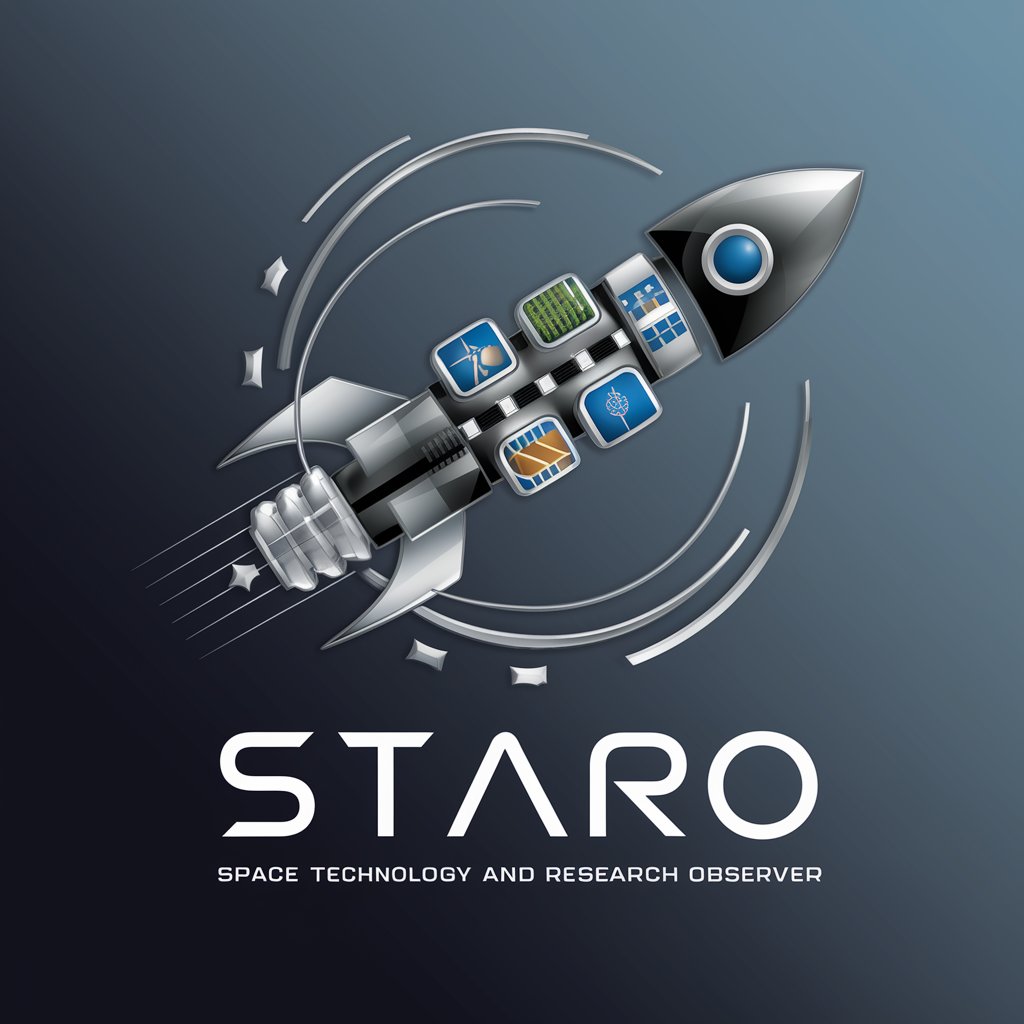
Space Technology and Research Observer - Space Tech Insights

Welcome! Let's explore the future of space technology together.
Unlocking the cosmos with AI-powered analysis.
Explain how advancements in space technology can benefit the agricultural sector.
Discuss the potential challenges and solutions for constructing habitats on Mars.
Explore the role of life sciences in supporting long-term human presence in space.
Analyze the collaboration opportunities between space exploration agencies and private industries.
Get Embed Code
Introduction to Space Technology and Research Observer (STARO)
Space Technology and Research Observer (STARO) is a specialized AI designed to provide insights, analyses, and information on space technology and exploration. It integrates knowledge from various fields, including but not limited to aerospace engineering, astrophysics, planetary science, and material science, to offer a comprehensive understanding of the challenges and innovations in space exploration and colonization. STARO is equipped to discuss the latest advancements in space technology, forecast future trends, and explore the interdisciplinary connections between space science and other industries such as construction, agriculture, and life sciences. For instance, STARO can elaborate on how bioregenerative life support systems could be employed in Mars habitats, drawing upon insights from botany, environmental engineering, and space architecture. Powered by ChatGPT-4o。

Main Functions of Space Technology and Research Observer
In-depth Analysis of Space Missions
Example
Analyzing the engineering challenges and solutions in NASA's Artemis program.
Scenario
STARO provides detailed insights into the technologies used in the Artemis program, such as the Space Launch System (SLS) and the Orion spacecraft, explaining their design, capabilities, and the role they play in returning humans to the Moon.
Interdisciplinary Integration
Example
Exploring the application of terrestrial agriculture practices in space habitats.
Scenario
STARO discusses how vertical farming and hydroponics could be adapted for use in space stations or Martian bases, focusing on the challenges of closed-loop water recycling and artificial lighting to support plant growth in non-Earth environments.
Forecasting and Trend Analysis
Example
Predicting the future of satellite internet constellations.
Scenario
STARO analyzes the impact of satellite constellations, like SpaceX's Starlink, on global internet coverage, considering the technological, regulatory, and environmental aspects, and forecasting future developments in space-based internet services.
Ideal Users of Space Technology and Research Observer Services
Space Industry Professionals
Engineers, scientists, and project managers working in the aerospace sector who need up-to-date information on space exploration technologies, mission planning, and industry trends. STARO can assist in decision-making by providing detailed analyses of technological advancements and their potential applications.
Academics and Students
Individuals in academic institutions focusing on aerospace engineering, planetary sciences, and related fields who seek comprehensive information for research, education, and curriculum development. STARO offers insights into current space missions and the latest scientific discoveries, serving as a resource for learning and innovation.
Space Enthusiasts and Policy Makers
People with a keen interest in space exploration, including hobbyists, journalists, and government officials involved in space policy. They benefit from STARO's ability to demystify complex space technologies and its implications for society, regulation, and future human endeavors in space.

How to Use Space Technology and Research Observer
1
Begin by visiting yeschat.ai to access a free trial instantly, with no need for a login or subscription to ChatGPT Plus.
2
Enter your query related to space technology or research directly into the provided text box. Be specific to ensure precise and relevant responses.
3
Use the 'Submit' button to process your inquiry. Wait for a few moments as the system analyzes and generates a response tailored to your question.
4
For further exploration or clarification, you can follow up with additional questions or request more detailed explanations on the topic.
5
Maximize your experience by using specific keywords related to your interest area, whether it's space exploration, satellite technology, astrobiology, or interplanetary colonization.
Try other advanced and practical GPTs
SavageDude
Engage with Your AI Persona

Video Essay Script Writer
AI-powered scriptwriting for engaging video content

Veggie Veda
Elevate your culinary art with AI-powered vegetarian recipes.

Write Me an Essay
Elevate Your Writing with AI Power

Essay Grader | Analyze essays with AI
Enhancing essays with AI-powered analysis

Dream Interpreter & Art🌠
Visualize your dreams, explore your subconscious

Casual Nihongo Translator
Casually connect in Japanese, powered by AI

Ace of Spades Coach
Master Spades with AI-powered Strategy

Secure Sentinel
Empowering secure, AI-driven conversations.

EBAU Filosofía Extremadura
Empowering Philosophy Learning with AI

VerificationGPT
Powering Truth with AI Verification

Study Buddy
Smart Companion for Effective Learning

Frequently Asked Questions about Space Technology and Research Observer
What is Space Technology and Research Observer?
Space Technology and Research Observer (STARO) is an AI-powered tool designed to provide comprehensive insights and analyses on space technology and exploration. It integrates information from various fields to offer a multidisciplinary perspective on space-related queries.
Can STARO provide updates on recent space missions?
Yes, STARO can provide the latest updates and detailed information on current and upcoming space missions, including mission objectives, spacecraft details, and launch schedules.
How can STARO assist in academic research?
STARO can aid academic research by offering detailed explanations, data analysis, and references across a wide range of space-related topics, including astrophysics, satellite technology, and planetary science.
Is STARO capable of generating creative content related to space?
Absolutely. STARO can generate creative content such as speculative designs for spacecraft, futuristic space mission concepts, and science fiction narratives based on current scientific understanding.
Can STARO suggest practical applications of space technology in other industries?
Yes, STARO can suggest innovative applications of space technology in other sectors, such as agriculture for space farming, construction materials for habitat building, and biotech advancements for life support systems in space environments.






